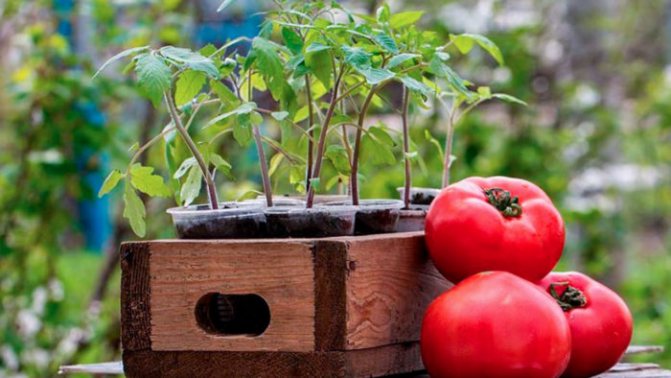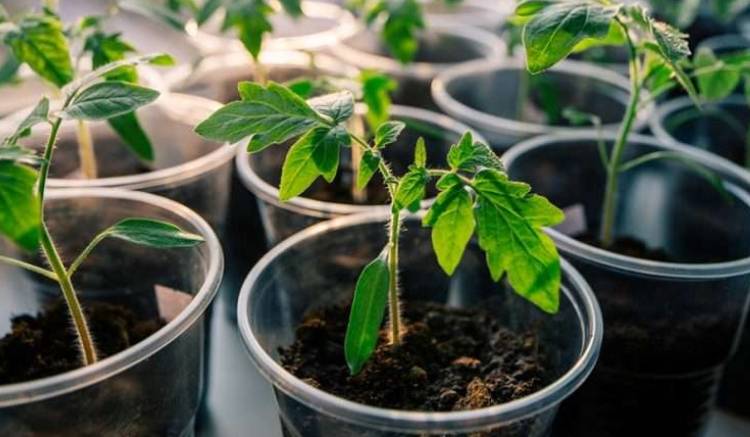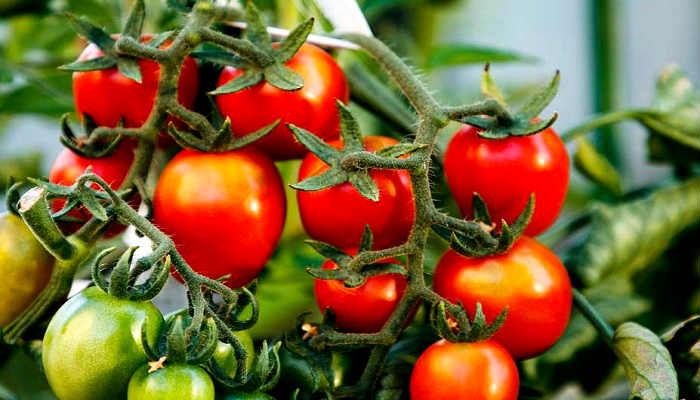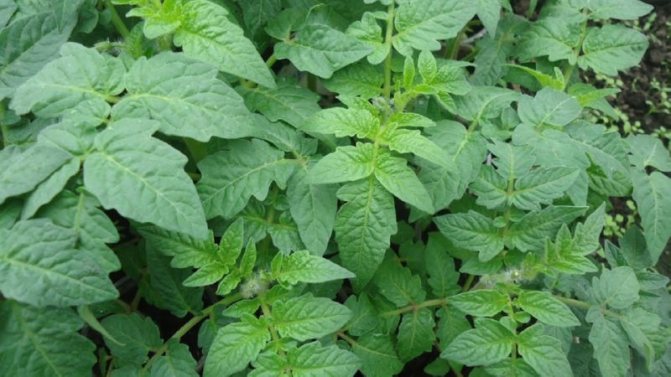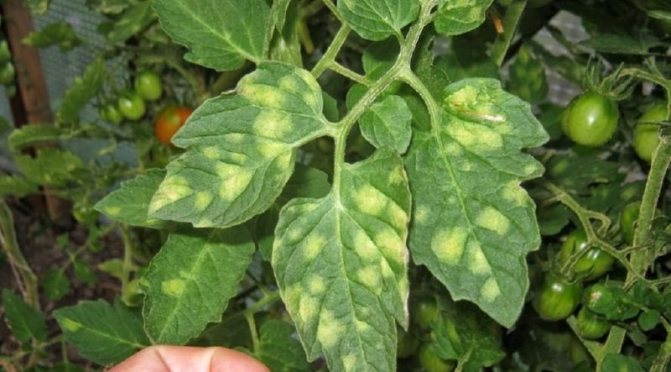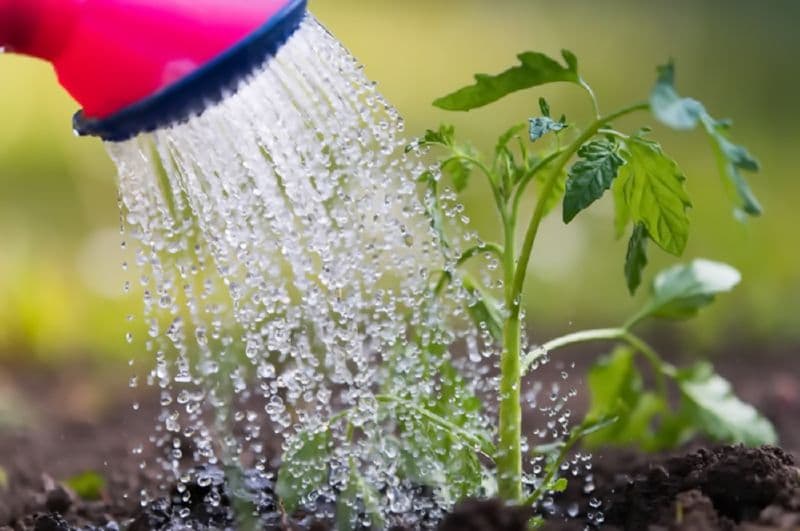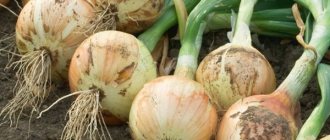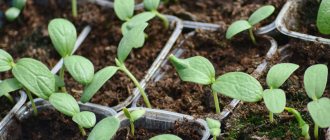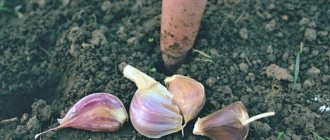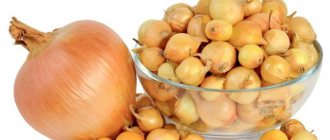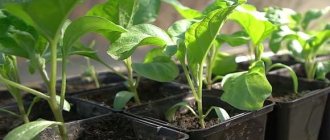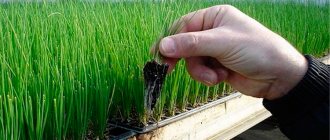Category: Garden plants
Tomatoes are one of the most popular garden crops, which are usually grown in seedlings. Healthy seedlings are the key to a successful tomato harvest, so it is necessary to take the process of growing it responsibly, and there are no trifles in this matter. We will tell you when tomato seedlings are planted for seedlings, how to grow tomato seedlings at home and when tomato seedlings are planted in a garden bed.
Content
- When to plant tomatoes for seedlings in 2020 January
- February
- March
- April
- May
- Priming
- Growing conditions
When to plant tomatoes for seedlings in 2020
Growing seedlings begins with determining the correct sowing dates. When to sow tomatoes for seedlings in 2020? The lunar sowing calendar will tell you about this:
Sowing tomatoes for seedlings in January 2020
| MON | VT | Wed | Th | PT | Sat | Sun |
| 1 | 2 | 3 | 4 | 5 | ||
| 6 | 7 | 8 | 9 | PL | 11 | 12 |
| 13 | 14 | 15 | 16 | 17 | 18 | 19 |
| 20 | 21 | 22 | 23 | 24 | NL | 26 |
| 27 | 28 | 29 | 30 | 31 |
Sowing dates of tomatoes for seedlings in February 2020
| MON | VT | Wed | Th | PT | Sat | Sun |
| 1 | 2 | |||||
| 3 | 4 | 5 | 6 | 7 | 8 | PL |
| 10 | 11 | 12 | 13 | 14 | 15 | 16 |
| 17 | 18 | 19 | 20 | 21 | 22 | NL |
| 24 | 25 | 26 | 27 | 28 | 29 |
Sowing tomatoes in March 2020 for seedlings
| MON | VT | Wed | Th | PT | Sat | Sun |
| 1 | ||||||
| 2 | 3 | 4 | 5 | 6 | 7 | 8 |
| PL | 10 | 11 | 12 | 13 | 14 | 15 |
| 16 | 17 | 18 | 19 | 20 | 21 | 22 |
| 23 | NL | 25 | 26 | 27 | 28 | 29 |
| 30 | 31 |
Sowing tomatoes for seedlings in April 2020
| MON | VT | Wed | Th | PT | Sat | Sun |
| 1 | 2 | 3 | 4 | 5 | ||
| 6 | 7 | PL | 9 | 10 | 11 | 12 |
| 13 | 14 | 15 | 16 | 17 | 18 | 19 |
| 20 | 21 | 22 | NL | 24 | 25 | 26 |
| 27 | 28 | 29 | 30 |
Growing tomato seedlings in May 2020
| MON | VT | Wed | Th | PT | Sat | Sun |
| 1 | 2 | 3 | ||||
| 4 | 5 | 6 | PL | 8 | 9 | 10 |
| 11 | 12 | 13 | 14 | 15 | 16 | 17 |
| 18 | 19 | 20 | 21 | NL | 23 | 24 |
| 25 | 26 | 27 | 28 | 29 | 30 | 31 |
The color in the table means what day it is for sowing:
| A great | Good | Normal |
| Bad | Horrible |
Do not sow tomatoes for seedlings on the new moon or full moon, because during these lunar phases, plant juices are collected either in the upper part, or, conversely, in the roots and tubers, which interferes with normal development. If you sow seeds with a growing moon, that is, after a new moon, the growth activity of the ground part increases, and in plants sown on a waning moon, after a full moon, the root system intensively develops. It follows from this that cereals should be planted in the waxing moon phase, and root crops in the waning phase. As for tomatoes, then culture is demanding, therefore, it is very important that the sowing of tomatoes for seedlings is carried out on favorable days for this.
How to properly grow pepper seedlings
Tomato varieties that grow well in open beds
1. The Black Prince. This variety is very productive, developed by Russian breeders. Fruits are red-brown, large. The taste of tomatoes is rich and sweet. The variety has a fairly good resistance to dangerous diseases.
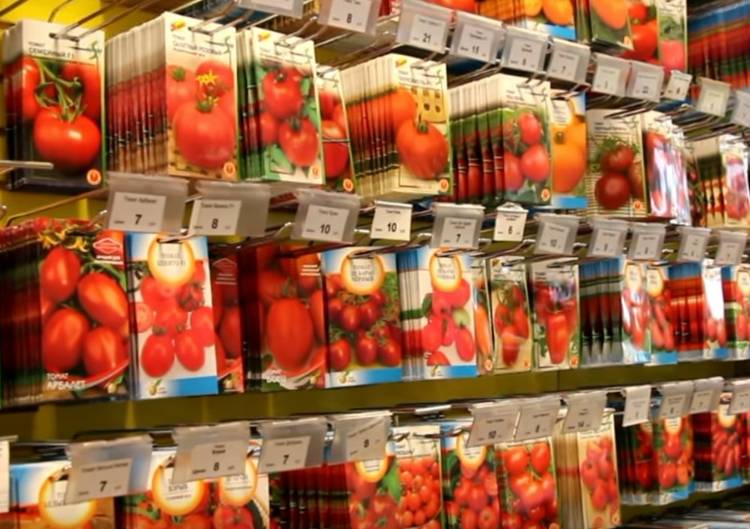
2. Korneevsky Red and Korneevsky Pink. Large fruits with a light sweetish taste, excellent resistance to diseases, need a garter, and further formation of a seedling.
3. Altai. It can be of different types - red, pink, honey-yellow fruits, resistant to cold, not demanding in care. The bushes are compact and neat, give a high yield.
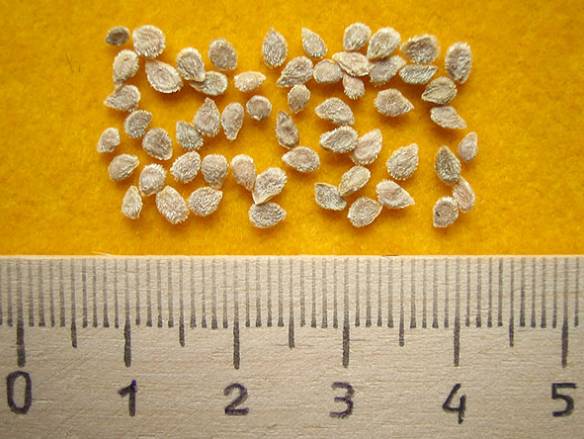

4. Bells of Russia. The variety grows well in all weather conditions.The fruits are elongated, perfect for canning.
5. Bullfinch. Quite an unpretentious tomato variety, suitable for salting or cutting into a salad.
6. Martha. It has a high yield, tolerates dry weather well, bears fruit until frost, and has excellent keeping quality.
Growing tomato seedlings at home
Soil for tomato seedlings
The main component of the soil for tomato seedlings is a mixture of humus and turf in equal parts. To make this mixture friable, sawdust or peat is added to it. You can buy ready-made seedling soil in the store.
- Thuja western: planting and care, description of varieties
Often, for growing seedlings, a mixture of black soil, sand and soil is used in equal proportions, but a little vermiculite must be added to this composition. Excellent results were shown by growing tomato seedlings in a mixture of sand and deoxidized high peat in a ratio of 1: 3. Good tomato seedlings are also obtained on coconut substrates - they have a healthy and strong root system, in addition, the seedlings are of high quality and fast growth.
However, whatever the composition of the soil for growing tomato seedlings you would prefer, its pH should be in the range of 5.5-6.0 pH, in addition, it is necessary to decontaminate the soil before sowing.
This can be done in several ways:
- calcine the soil mixture in the oven for 10-15 minutes at a temperature of 180-200 ºC;
- spill the soil with boiling water;
- warm up for a couple of minutes in the microwave at full power;
- shed the composition with a bright pink solution of potassium permanganate.
The soil is disinfected by any of these methods, moistened if it is dry, and left warm for a couple of weeks, so that during this time bacteria useful for tomatoes will multiply in it.
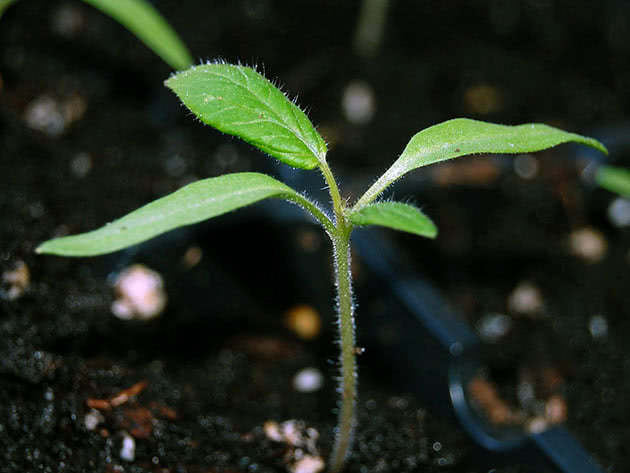

In the photo: Germinating tomato seedlings
Seedlings are also grown in peat tablets.
Planting tomatoes for seedlings at home
If you bought tomato seeds for seedlings from reliable producers, then you do not need to disinfect them before sowing - the seeds are already prepared for planting. Seeds collected by yourself or purchased on the market must be disinfected before sowing, as they can be infected with fungal, viral or bacterial infections.
There are several ways to disinfect inoculum:
- tomato seeds are soaked for a day or two in an aqueous solution of aloe juice (1: 1), purchased at a pharmacy or squeezed from the leaves of a plant with their own hands and kept in the refrigerator for 5-6 days. Tomatoes from seeds processed in this way are distinguished by good immunity, productivity and high quality of fruits;
- the seed is soaked for a day in a solution of one gram of soda in 200 ml of water - this treatment stimulates the early onset of fruiting;
- effectively soaking seeds in Fitosporin solution: a drop of the drug is diluted in 100 ml of water and the seed is immersed in this liquid for 1-2 hours;
- the seeds are wrapped in gauze and placed in a 1% solution of potassium permanganate for 15-20 minutes.
Sowing tomato seeds for seedlings is carried out in this way: a container for crops with drainage holes is filled with moist soil, grooves are made in it with a depth of no more than 1 cm at a distance of 3-4 cm from each other, seeds are laid in them with a step of 2-3 cm and sprinkled soil. Then the container is covered with glass or foil and placed near a heat source, since the optimum temperature for seed germination is 25-30 ºC.
How to grow healthy and robust eggplant seedlings
How to grow seedlings in tablets
Growing tomato seedlings in peat tablets makes it possible to do without picking seedlings, which in any case leads to their stress.To grow tomatoes, tablets with a diameter of 4 cm are needed, which are pre-poured for swelling with water at room temperature, and after the excess water drains off, they are placed in cells of a slightly larger diameter than tablets and placed in a transparent box at least 10 cm high.
From two to four seeds are sown in one such tablet, but if you are sure of the quality of the seed, you can sow one at a time - later you will not have to thin out the seedlings.
Make a hole 1-1.5 cm deep in the center of each tablet and place a seed there, and sprinkle it with soil or vermiculite on top. Cover the seed box with a transparent lid, glass or plastic and place in the conditions necessary for seed germination. With the emergence of seedlings, the cover is removed from the crops.
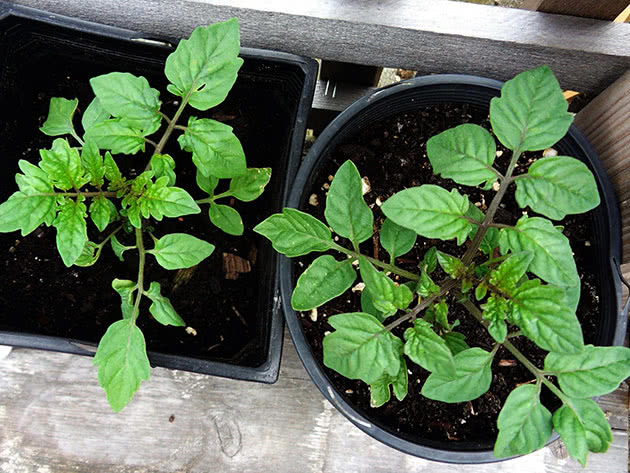

Photo: Grown tomato seedlings
Growing tomato seedlings in cassettes
Many gardeners prefer to use cassettes with a pallet for growing tomato seedlings.
- Firstly, in this case, the procedure for moistening the soil is greatly facilitated, since the method of bottom irrigation is used - through the pallet.
- Secondly, the same cassettes can be used repeatedly - they are made of high-quality polystyrene, they are easy to clean and wash.
- Thirdly, cassettes allow you to save space - all the seedlings can fit on one windowsill.
- Fourth, by growing seedlings in cassettes, you save yourself and the seedlings from the exhausting picking procedure, which often damages the root system of the seedlings.
On sale you can find cassettes with parameters 18x13.5x6 cm for 4 cells, the size of each of which is 8x6 cm, and the volume is 240 ml. You can purchase a cassette of the same size with a large number of cells with a smaller capacity - 6x5.5 cm and a capacity of 155 ml. There are cassettes for nine and twelve plants, but for tomato seedlings it is better to choose a cassette with larger cells. The most convenient type of cassettes is in a box: the pallet in such a box is made of dark plastic, and the lid is made of transparent. The cover protects the substrate from moisture evaporation, creates a greenhouse effect and transmits light well.
- Thuja western: planting and care, description of varieties
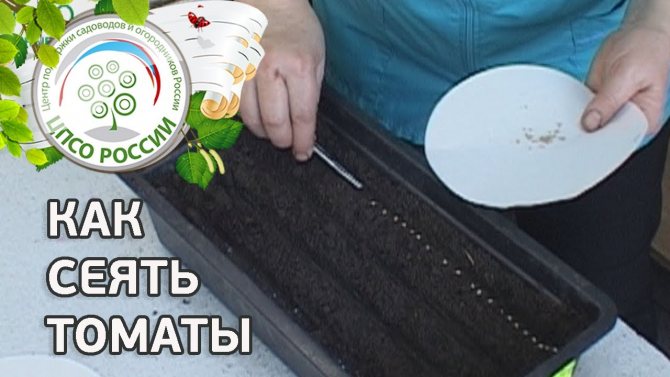

How to grow tomato seedlings in cassettes? The use of cassettes as a container for seedlings has its own characteristics: due to the small volume of cells, the soil in them dries out quickly and loses nutrients, therefore, a mixture of agroperlite with high-moor peat in a ratio of 1: 3 is more suitable for growing in cassettes. Peat is preliminarily deoxidized by mixing 10 buckets with 1 kg of chalk and adding to the mixture 50 g of ammonium nitrate, 30 g of magnesium sulfate, 100 g of potassium nitrate and 150 g of superphosphate. Do not forget to decontaminate the soil mixture before fertilizing it.
Disposable cassettes do not require sterilization, and those that have already been used need to be disinfected. After disinfection, place the cassette on a pallet, fill the cells with prepared wet soil, tamp it, make holes 1-1.5 cm deep in it, spread the seeds that have undergone pre-sowing treatment in them, and seal the holes.
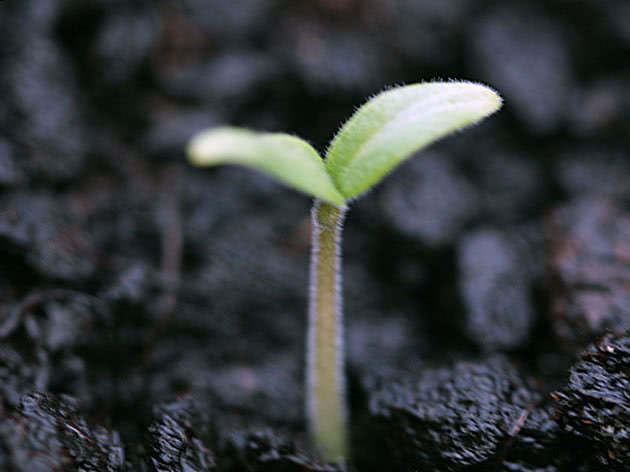

In the photo: Only hatched seedlings
But it is much easier and more convenient to use peat tablets for growing seedlings in cassettes - after swelling in water, they are laid out in cells and seeds are sown in them in the way that we have already described.
Tomato seedlings in the greenhouse
Our website has already posted an article on how to grow tomatoes in a greenhouse, but how to grow tomato seedlings in a greenhouse, we will tell you now, especially since it is the most reliable and efficient way to produce strong, healthy tomato seedlings.
After preparing the soil in a heated greenhouse, make 3-5 cm deep furrows in the garden bed at a distance of 15-20 cm from each other and spill these furrows well with water.Dry disinfected seeds are sown in 1-2 cm increments, after which the furrows are sealed with wet sand or peat.
Growing tomatoes in a greenhouse - planting and care
The seedlings are thinned when they develop the first pair of true leaves, leaving a distance of 5-7 cm between the seedlings. After the procedure, water the soil well to eliminate the air jams formed in it. In the development phase of the seedlings of three pairs of leaves, the second thinning is carried out with a step of 12-15 cm. After the second procedure, for the development of the root system of the seedlings, a layer of soil 3-6 cm thick should be added to the bed, and the row spacing should be mulched with sand, sawdust or peat.
Buy tomato seedlings - is it worth it?
If for some reason you did not manage or did not manage to grow tomato seedlings on your own, of course, you will have to buy it, and it is better to contact a well-established nursery for this - there you are unlikely to be deceived by foisting one variety into another, and they will try answer all your questions. Anything can happen on the market.
But if you nevertheless decide to purchase seedlings on the market, heed our advice:
- choose seedlings that are no more than 45-60 days old: their height should not exceed 30 cm, seedlings of low-growing and early varieties should have 6-8 leaves, and tall ones - 11-12 leaves;
- seedlings should be strong, with a stem as thick as a pencil, rich green leaves and a formed root system without mechanical damage;
- carefully inspect the underside of the leaves for any pests or their eggs. If the seedlings have shriveled or otherwise deformed leaves, this may be a symptom of an infectious disease. Pay attention to the stems of the seedlings for brown or black spots. Do not buy seedlings from the seller if you find signs of disease or the presence of harmful insects on at least one plant;
- if the seedlings look healthy, but the edges of their bright green leaves are curled down, under the leaf, this may indicate that the seller grew the seedlings in an accelerated way, overfeeding them with nitrogen fertilizers - such seedlings should not be bought;
- seedlings must be fresh and sold in boxes of soil.
And yet, even if you manage to get good seedlings, homemade tomato seedlings that you have grown yourself are still better.
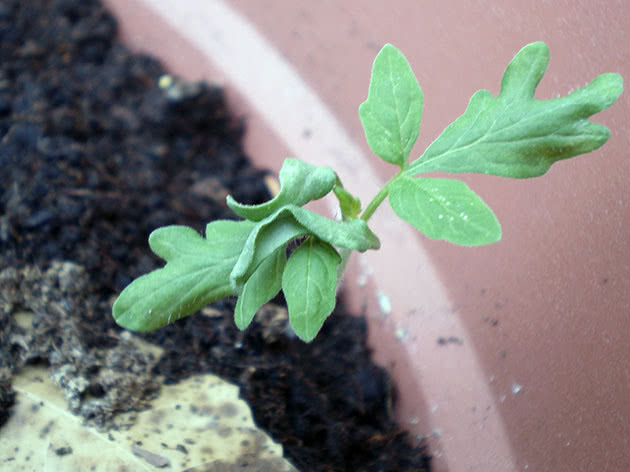

In the photo: Tomato seedlings with the first true leaves
Rules for choosing tomato varieties
The choice of tomato varieties must be approached responsibly. Vegetable varieties should be highly resistant to temperature extremes, grow well in dry and sultry weather, withstand cold snaps, and not lose useful properties during frosts.
In the beds, it is preferable to grow specially bred varieties that give a large yield, as well as hybrid varieties of tomatoes.
In order for tomato varieties to ripen before the first frost, early or mid-early tomatoes are usually transplanted into the beds.
Later varieties do not have the opportunity to ripen before the onset of the first cold weather. All fruits will differ in size, pulp condition, fruit color and shape, taste characteristics.
In the open field, determinant bushes of small size grow well, which do not require pinching and subsequent formation.
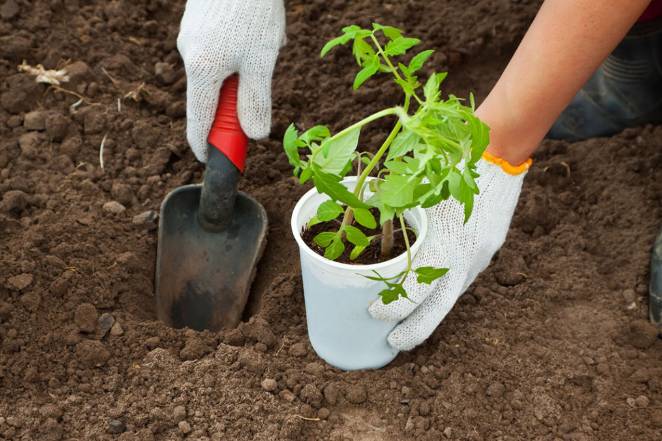

If they are planted in unprotected ground, then there is a chance that they will not branch and stretch. Indeterminate plants look more compact, they require fastening, and there is a need to fix not only the stems, but also the branches with heavy hanging fruits.
Caring for tomato seedlings at home
Conditions for growing tomato seedlings
The germination period of seeds depends on the quality of the seed, the conditions of the crops and the variety of tomatoes. If you adhere to the recommended keeping temperature (25-30 ºC), the seeds will germinate in 3-4 days.At a temperature of 20-25 ºC, the seedlings will begin to break through in 5-6 days, and if the temperature in the room is 10-12 ºC, then the sprouts will appear not earlier than in two weeks.
As soon as the first shoots appear, the temperature of the content is lowered for a week to 14-16 ºC in order to avoid stretching the seedlings. Crops are placed in the brightest place, but natural light may not be enough, and you will need to arrange additional artificial lighting for the growing seedlings.
Ventilate crops daily and remove condensation from the cover, otherwise mold may form on the soil surface. When the mass germination of seeds begins, the cover is removed from the crops, the daytime temperature is raised to 20-22 ºC, and the nighttime temperature - up to 16-18 ºC. By adjusting the room temperature, protect seedlings from drafts.
Watering tomato seedlings
It is necessary to moisten tomato seedlings with great care, as they can easily rot. If the substrate holds moisture well, then do not water the soil from the moment of sowing until the first true leaf appears at the seedlings. If the soil dries up, it is better to moisten it with a spray bottle, being careful not to wet the stems of the seedlings. In the future, watering is carried out once a week, and at the stage of development in seedlings of five true leaves, the soil begins to moisten once every 3-4 days.
For watering and spraying, use settled or filtered water two to three degrees warmer than room temperature.
- Thuja western: planting and care, description of varieties
Top dressing of tomato seedlings
Whether your seedlings need feeding, you can determine by its appearance: seedlings with a strong, plump stem and juicy green leaves do not need fertilizers. But if the appearance of your seedlings gives you the suspicion that they are not getting enough nutrition, apply fertilizer to the soil.
How and when to plant cucumbers for seedlings - tips from the pros
How to feed tomato seedlings, and when is it better to do it? Add a solution of 1 teaspoon of Agricola Vegeta and the same amount of Kornerost in 1 liter of water to the soil at the stage of development in seedlings of 1-2 leaves, and when the seedlings have a third leaf, a solution of one tablespoon of Effekton-O in a liter will be a good feeding for them water. It is necessary to water the soil with nutrient solutions carefully, trying to prevent the liquid from getting on the leaves and stems of the seedlings.
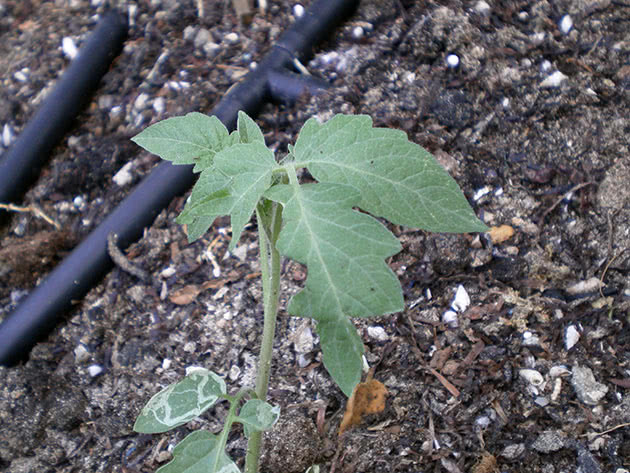

In the photo: Planted tomato seedlings
Highlighting tomato seedlings
Tomatoes are very demanding on lighting. From a lack of light, the seedlings stretch out, grow weak and frail. The duration of daylight hours for tomato seedlings should be at least 12 hours, so you need an additional light source, and in the first 2-5 days from the moment of germination, artificial lighting should work around the clock.
To organize the lighting, it is better to purchase a fluorescent lamp or phytolamp, and place it above the seedlings at a height of 20-25 cm.
Picking tomato seedlings
If you grow seedlings in a common box or container, at the stage of development in seedlings of three true leaves, they are dived into separate half-liter pots or cups with drainage holes. If you transplant seedlings into smaller containers, you will have to pick one more time, which is unwise. The cups are filled with moist soil, compacted, and a deepening is made in it. The seedling is carefully removed from the soil, pinch its main root by a third of the length, after which it is transplanted to the plant in a glass and squeezed the soil around its stalk. For the first 3-4 days after the pick, the temperature in the room is increased by 2-3 degrees, and as soon as the seedlings take root, it is lowered to the previous level.
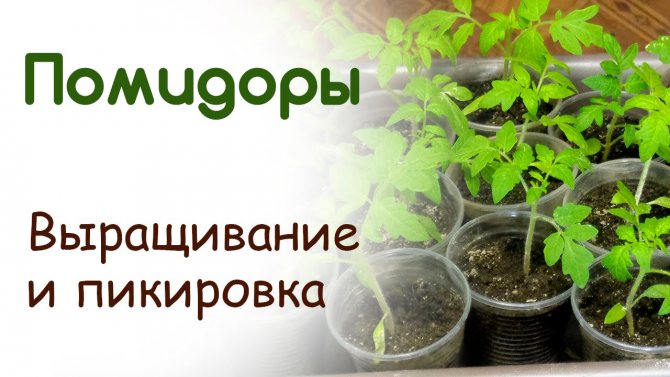

Pinching tomato seedlings
There is another way to transplant seedlings after a pick - two in one pot.When the seedlings take in and stretch up to 10-15 cm, their stems are tightly tied to each other with a nylon thread. After complete accretion, the thread is removed, and the tip of the weaker seedling is pinched. As a result, you will have a strong seedling with a strong root system.
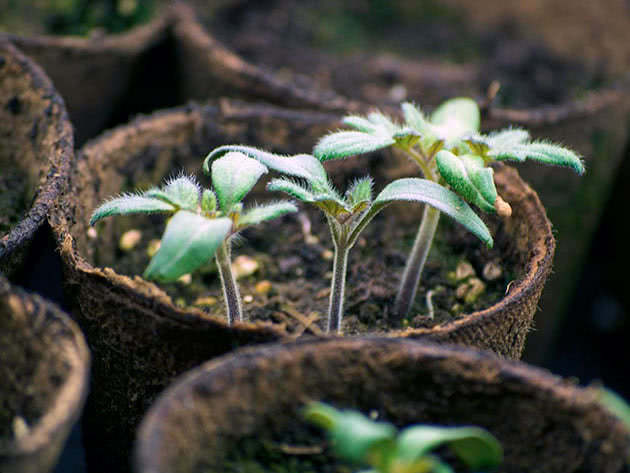

In the photo: Tomato seedlings in peat pots
Features of work for different regions
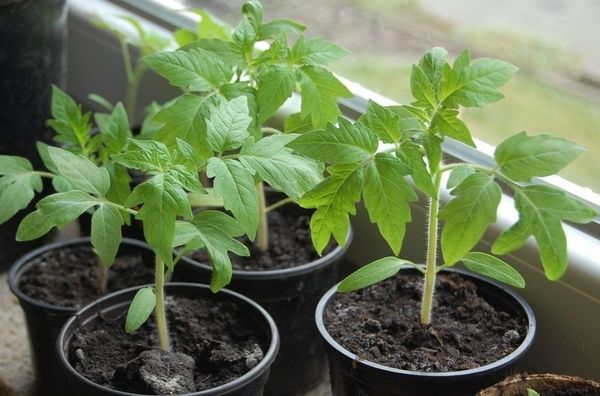

Planting tomatoes according to the lunar calendar for a greenhouse does not guarantee a perfect result. It is necessary to take into account the region in which the work is carried out, since the warm period begins in different ways and it is worth choosing the optimal time taking into account the climatic conditions of the landing site. Here you need to remember the following:
- For the Moscow region and central Russia, the landing should be carried out in early or mid-March. Then, by the end of April or the beginning of May, the plants will be ready to move to the greenhouse and take root well.
- Siberia and the Urals are distinguished by a later spring, so the dates should be shifted by 2-3 weeks. The exact period should be selected depending on the climate, since it varies greatly even in neighboring areas.
- For the southern regions, on the contrary, shift the dates to an earlier date and carry out work in February.
- When the greenhouse is heated, adjust the sowing days individually. Decide in advance from what period to use heating, based on this, calculate the timing in order to receive seedlings on time.
It is not difficult to determine the sowing time if you know the peculiarities of the climate in the region. In the greenhouse, the soil warms up 2-3 weeks earlier than on the street, because of this, the dates are shifted. Do not overexpose plants in pots, as they begin to stretch, and when transplanted, they take root much worse and adapt longer.
Diseases of tomato seedlings and their treatment
Tomato seedlings turn yellow
There are several reasons for this phenomenon:
- Yellowness on the leaves may appear from exposure to low temperatures, due to insufficient soil in the container, or from poor lighting.
- And it happens that during transplantation, the roots form a dense lump, and the seedling has difficulties with nutrition.
- Sometimes the leaves turn yellow after transplanting due to microtrauma in the roots.
- Tomato seedlings turn yellow at home and from a lack of nutrients in the soil - nitrogen or other elements.
- A possible cause of yellowness can also be a disease, for example, black leg or brown spot.
Tomato seedlings are rotting
The most common cause of rotting seedlings is excessive soil moisture, especially if there is no drainage. Do not make such mistakes, and if you find signs of decay, remove the affected plants, loosen the soil and sprinkle it with wood ash on top. And, of course, reconsider your attitude towards watering. Seedlings also rot from diseases.
Diseases of tomato seedlings
The most common diseases affecting tomatoes in the seedling stage are black leg, white and brown leaf spots, black bacterial spot, bacterial cancer, streak, late blight and mosaic.
Blackleg is a fungal disease transmitted through the soil, and high air temperature and high humidity provoke its activity. In the affected plant, the base of the stem darkens, and then the base of the stem turns black, a constriction forms on it, and as a result, the seedling lays down, and its roots rot.
The hazard level can be reduced by adding wood ash to the soil. As a preventive measure, do not neglect the sterilization of the soil mixture and seeds before sowing and control the moisture content of the soil.
Affected plants must be removed.
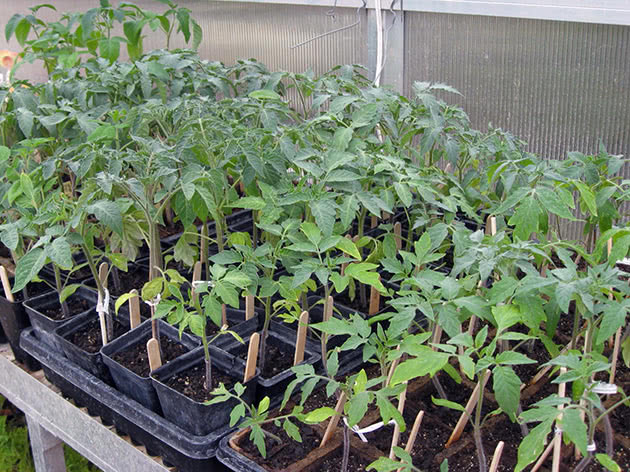

Photo: Grown tomato seedlings in individual pots
White leaf spot appears as dirty white spots with black dots and a dark border on the lower leaves, which gradually turn brown, dry and fall off. Infection penetrates from contaminated soil.At the first signs of the disease, all affected seedlings must be removed, the soil must be shed with a solution of potassium permanganate and powdered with wood ash, and healthy plants must be treated with Bordeaux liquid or another copper-containing fungicide.
Brown leaf spot initially appears as vague yellowish spots on the upper side of the leaves and olive-colored bloom on the lower side. Gradually, the spots darken and spread over the entire leaf plate, and the plaque becomes dark brown. Sick leaves dry and fall off. The disease is actively developing against the background of high humidity and air temperature. Destroy the infection by treating the seedlings with a fungicide solution, after removing the affected specimens.
Late blight is transmitted through seed, soil and airborne droplets and more often affects seedlings suffering from a lack of copper, potassium, iodine and manganese. Phytophthora is destroyed with a fungicide solution, but this rarely succeeds the first time.
Bacterial black spot is transmitted through non-sterile soil or seeds and appears as black spots on the terrestrial organs of plants. The affected seedlings must be immediately removed and destroyed, the soil should be shed with a solution of potassium permanganate and powdered on top with wood ash, and the seedlings should be treated with a solution of a copper-containing fungicide.
Bacterial cancer affects the vascular system of plants and causes them to wilt. It can be diagnosed by light rounded spots with a gradually darkening center, similar to a bird's eye. Diseased plants are destroyed immediately, and healthy plants are sprayed with a fungicide.
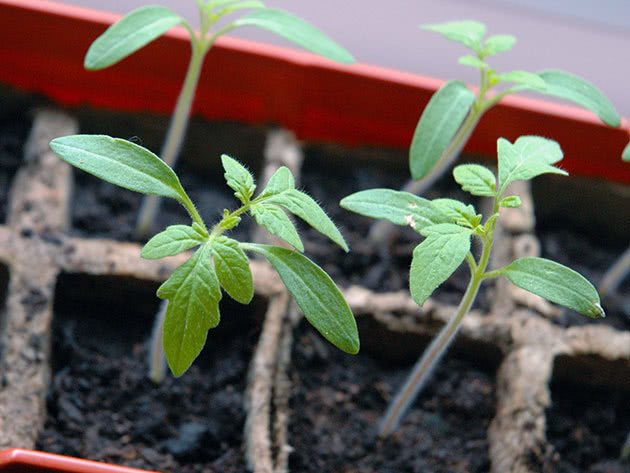

Pictured: Tomato seedlings in a peat cassette
Streak, or streak, is caused by a virus, which means there is no cure for the disease. The virus is transmitted by seeds of infected plants. Diseased seedlings are covered with strokes, stripes and specks of a reddish-brown hue, the leaves die off, and the petioles and stems become fragile.
Mosaic is also a viral disease that gives the leaves of plants a variegated color: on them dark green spots alternate with light, almost yellow ones. As a result, the leaves curl up and die off. Drugs for the treatment of viral diseases have not yet been invented, so one has to be content with preventive measures, including careful selection and pre-sowing seed treatment. If you find signs of a mosaic on the seedlings, remove and destroy the affected seedlings immediately.


